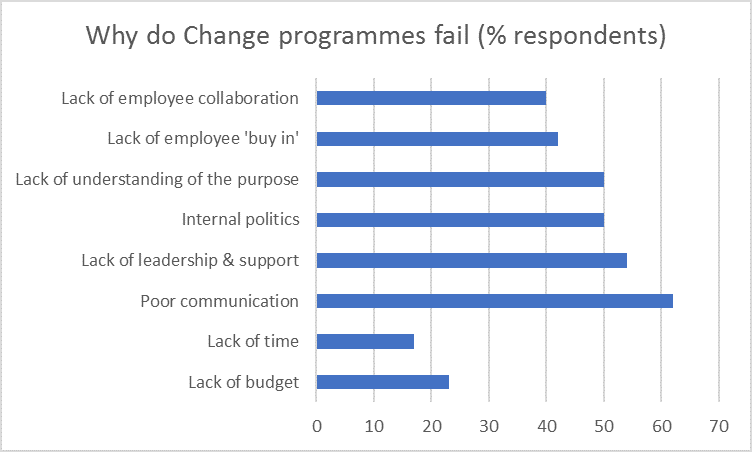Leading through change: How to beat the odds
Just like a cyclone, COVID-19 has thrown everything up in the air, moving forward many business owners are faced with leading their businesses through major changes to survive.
The only person who welcomes change is a wet baby
It is true right?
However sometimes, like now, big and complex changes may be required, and in very short timescales. Implementing a successful change is one of the hardest parts of leadership, with 88%* of change programmes failing to deliver expected results.
So, what are the key elements of successful change?
Reflecting on my academic work in Change Management and my own experience of leading change (some well, others not so well) Here are my top 3 insights to beating the odds.
Systems and processes change, people transition
There are 3 components that impact and are impacted by major change
- Systems
- Processes
- People
Leaders often focus on the getting the systems and the processes in place – re writing documents, upgrading equipment and minimum time on the people. Yet when we look into the reasons that changes fail; it’s poor communication, lack of leadership and purpose – the human aspects that rank the highest.
The fact is people don’t change, they have to transition from the old way of doing things to the new and whilst you can change a process in one simple hit, you can only transition people one at a time. Each member of your team will react to and manage change differently. What are the impacts on them and their role day to day?
Key to successful change is to focus on supporting the people; individual by individual will determine whether, over time your change is successful or not.
“The hand that clings to an old friend cannot embrace a new one”
James Clear tweeted that comment recently and it sums up perfectly the first part of any change. Letting go of the old, the comfortable, that well-trodden path. A simple model of change (Lewin, 1951) helps us to understand change in 3 distinct stages: Unfreezing, Change and Refreezing.
In reality, the middle bit, the change is simplest part. The first challenge is to unfreeze , ensuring that people are ready for the change. The 3 key aspects here are
To listen & involve – the biggest misconception of leadership is that you need to have all the answers, yet both from a practical and motivational point of view allowing your team to come up with ideas and make suggestions, asking their opinion and seeking feedback is the best way of getting them on board with what needs to happen.
Motivate – explaining what they need to do is important but getting them emotionally committed to achieving it makes the biggest difference. You need to paint a clear vision of the future, what will success look and feel like and most importantly how will it impact them.
Build a path – be clear on what they are expected to do and how; work hard to move or minimise the obstacles in the way.
A perfect metaphor for this was created by psychologist, Jonathan Haidt, it is explained and adapted for change in this 2 min video - the Elephant the rider and the path https://www.youtube.com/watch?v=X9KP8uiGZTsKeep the boulder rolling - make changes stick
Imagine you and your team have to push a giant boulder, at the start to get it moving there is a lot of action and effort, communication, it’s all hands on the boulder pushing together, when it gets rolling momentum starts to take effect, the effort required becomes well understood: push, repeat. The communication becomes less and those not directly involved in pushing move on to other things. One day the team member pushing wonders “why exactly am I still pushing this boulder?” and they begin to slow down, momentum is lost, they can’t push it on their own after all and they can’t remember why it was so important to move it anyway - the boulder stops. (In the worse case the boulder may even roll back to where it started from)
Ok so perhaps a long-winded metaphor but you get the idea – making changes stick over time is vital, refreezing the business into a new way of working.
Building it into everyday practice, ensuring that the changes are considered in employee performance measures and regularly reviewed with other business goals.
Ensuring, where appropriate that ongoing training and support are provided
Creating quick wins (the first week or month) and celebrating success are ways to ensure that everyone continues to view the change as important.
Keep that boulder rolling.
The pace of change isn’t going to slow down anytime soon
So, COVID 19 has meant that we have all been faced with significant changes in a very short space of time, yet looking ahead the drivers of change; rapidly evolving technology, challenging economy, political changes and social trends means that the pace of change is not going to slow down anytime soon. We need to get used to it and to get better at making it happen .
If you would like some help to deliver the changes needed in your business, then please get in touch to find out how I can help.
Janet Doran , works as a Business Coach across North Yorkshire, UK. enabling small business owners in creative and professional service industries to win in competitive markets. To explore use working together on your business please get in touch janet@thepositivepenco.uk
Find out more at www.thepositivepen.co.uk or call 07505 120051
Posting daily, information/inspiration for small business owners, on twitter @ thepositivepen













